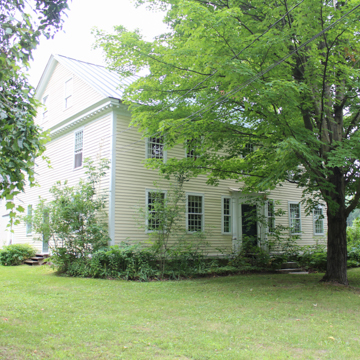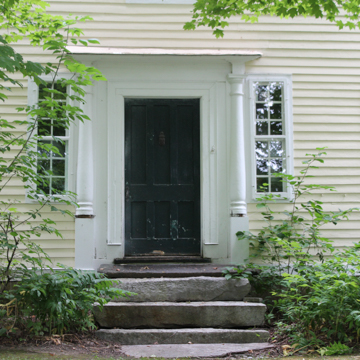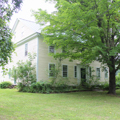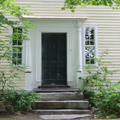This house, built for first-generation residents of Georgia, is the best-preserved example of a work that bears the mark of joiner William Sprats. Sprats lived at the foot of Lake Champlain, in the area of Whitehall, New York, but he worked in Franklin County, building an important meetinghouse in Georgia in 1802 (burned 1952). At the time, Georgia was the most populous town in northwest Vermont, occupied by settlers from southwestern Vermont (many originally from Litch field County, Connecticut) who had been enticed northward by speculator brothers Ira and Ethan Allen. Georgia also benefited from regular contact down the lake with a network of former Connecticut residents, including Sprats and his patron Simeon Smith (RU53). The Evarts house was built on the original “governor's” lot in Georgia that Ira Allen deeded to his niece Sarah and her husband, Reuben Evarts, an early town official. The house is a substantial, modified-Georgian-plan building with twin interior chimneys. Originally, it had a low-hipped roof, but this was replaced by a more practical pitched gable in 1835, at the time the rear wing was added. It has a finely scaled modillioned cornice, a front door flanked by Tuscan columns on pedestals that carry a simple entablature, and parlor fireplaces with fluted and paneled pilasters and modillioned entablatures. If not by Sprats himself, it certainly reflects the style his contemporaneous meetinghouse brought to town.
You are here
Evarts House
If SAH Archipedia has been useful to you, please consider supporting it.
SAH Archipedia tells the story of the United States through its buildings, landscapes, and cities. This freely available resource empowers the public with authoritative knowledge that deepens their understanding and appreciation of the built environment. But the Society of Architectural Historians, which created SAH Archipedia with University of Virginia Press, needs your support to maintain the high-caliber research, writing, photography, cartography, editing, design, and programming that make SAH Archipedia a trusted online resource available to all who value the history of place, heritage tourism, and learning.





